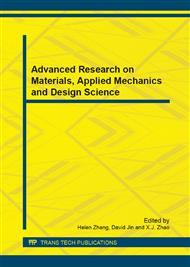p.233
p.237
p.241
p.246
p.250
p.256
p.263
p.267
p.271
Simulation on Computational Fluid Dynamics of Flow Field and Pollutant Dispersion in Block of Buildings
Abstract:
With the social development, motor vehicle exhaust has become a major source of pollution in the city today, so it is necessary to research the effect of the wind field around buildings and pollutants dispersion on human health. In this paper, we using Fluid Dynamics method to simulate the pollutants dispersion under different wind direction. The results showed that the maximum wind speed of the buildings in the same horizontal plane appeared in the entrance of the street. When the inflow velocity, wind directions are different, the air flow distribution is different in group of buildings. Pollutants are prone to accumulate in the place of low wind speed, atmospheric instability, and weak turbulence intensity. The concentration of pollutants from lower to upper gradually reduced, but it will appear opposite situation in the vortex.
Info:
Periodical:
Pages:
250-255
Citation:
Online since:
June 2013
Authors:
Price:
Сopyright:
© 2013 Trans Tech Publications Ltd. All Rights Reserved
Share:
Citation:


